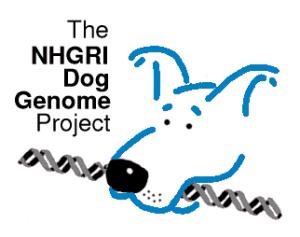Dog Genome Yields Clues to Human Cancer
IRP Research Identifies Genetic Risk Factors for Highly Lethal Disease

A new IRP study searched the genomes of flat-coated retrievers like this one to identify genetic risk factors for a highly lethal form of cancer that is rare in humans but common in that breed.
We may share our food and even our beds with them, but despite what many dog lovers might like to believe, our canine companions are not humans who just happen to walk on four legs. One thing we do have in common, though, is the array of genetic diseases that afflict both man and man’s best friend. As a result, scientists can learn a great deal about human illnesses by studying dogs. Using this approach, IRP researchers recently discovered genetic variants that likely play an important role in a rare and poorly understood form of cancer.1
Histiocytic sarcoma is a very rare and highly aggressive cancer of blood cells, and most patients do not live longer than two years past their diagnosis due to a lack of effective treatments. Efforts to develop therapies for the illness have been hampered both by its rarity and the fact that it stems from a different set of blood cells from those involved in more common blood-based cancers like leukemia and lymphoma.
In certain dog breeds, on the other hand, histiocytic sarcoma is common. Roughly one in five flat-coated retrievers and one in four Bernese mountain dogs gets the disease, and they fare no better than their human counterparts. Certain breeds commonly develop specific diseases because of the selective breeding that produces their distinctive physical traits. This practice requires allowing only a small number of dogs to breed, dramatically shrinking the pool of possible genes within each breed and vastly increasing the likelihood of inheriting disease-causing genes that would otherwise be rare.
“Each of the roughly 350 breeds is a relatively closed breeding population,” explains IRP senior investigator Elaine Ostrander, Ph.D., the new study’s senior author and the leader of the Dog Genome Project at the National Human Genome Research Institute (NHGRI). “In order to be a registered cocker spaniel, your parents have to be registered cocker spaniels and your grandparents have to be registered cocker spaniels.”

Histiocytic sarcoma is common in flat-coated retrievers (top-left) and Bernese mountain dogs (top-right). Golden retrievers (bottom-left) and rottweilers (bottom-right) are also prone to developing the disease, but less so than the other two breeds.
As a result, studying dogs can make it much easier to suss out genes involved in diseases that afflict both humans and dogs. In the new study, Dr. Ostrander’s team — led by IRP postdoctoral fellow Jacquelyn Evans, Ph.D., the paper’s first author — scoured the genomes of 177 flat-coated retrievers with histiocytic sarcoma and 132 healthy dogs of the same breed to find genetic variants that increase risk for that cancer. The dog DNA samples her lab uses come from thousands of owners and breeders around the globe, making the Dog Genome Project one of the largest ‘citizen science’ efforts in the world.
The analysis identified two stretches of DNA, one on canine chromosome 5 and one on chromosome 19, related to risk for histiocytic sarcoma. Interestingly, the region on chromosome 5 overlaps with a region in the genome of golden retrievers associated with two forms of blood cell cancer common in that breed. Together, the two genetic sites the new study highlighted explain roughly 35 percent of the risk for histiocytic sarcoma in flat-coated retrievers.
“It’s really remarkable that there’s two genetic loci that explain such a high percentage of risk for the disease,” Dr. Ostrander says. “That’s extraordinarily high, but when you have a disease where 20 percent of the dogs die from it, you would expect that the genetic variants underlying it are a big deal.”

More From the IRP
Blog
Labradors, Terriers, and Boxers — Oh My! IRP Researchers Delve Into Doggy DNA
Further experiments specifically pinpointed genetic variants at the locations of the PIK3R6 gene on canine chromosome 5 and the TNFAIP6 gene on chromosome 19 as being strongly linked to risk for histiocytic sarcoma. Moreover, genetic changes seen in some of the dogs with the disease were associated with greater activity of the TNFAIP6 gene. Finally, the researchers found evidence suggesting that some of the PIK3R6 variants likely change how molecules called transcription factors bind to the DNA at that genetic site, which could alter how the gene behaves.

Dr. Elaine Ostrander
Other researchers can now hone in on the genes highlighted by the IRP study to learn more about how they are involved in histiocytic sarcoma and similar cancers, as well as to develop therapies that affect the biological processes those genes influence. Meanwhile, Dr. Ostrander’s lab is focused on identifying still more genes associated with histiocytic sarcoma in dogs by analyzing DNA from Bernese mountain dogs. That breed is much more common in the U.S. than flat-coated retrievers, allowing her team to collect DNA from many more dogs and boosting the researchers’ ability to identify disease-associated genes.
“Our study certainly validated the idea that dogs are a good genetic model for studying cancers, and they’re a way to simplify the problems we face in human cancer genetic studies,” Dr. Ostrander says. “For most cancers, there are many genetic variants that appear to contribute, so we’re always looking for ways to simplify the problem. You can find susceptibility genes in dogs, and they really do have relevance in human health and biology.”
Subscribe to our weekly newsletter to stay up-to-date on the latest breakthroughs in the NIH Intramural Research Program.
References:
[1] Multi-omics approach identifies germline regulatory variants associated with hematopoietic malignancies in retriever dog breeds. Evans JM, Parker HG, Rutteman GR, Plassais J, Grinwis GCM, Harris AC, Lana SE, Ostrander EA. PLoS Genet. 2021 May 13;17(5):e1009543. doi: 10.1371/journal.pgen.1009543.
Related Blog Posts
This page was last updated on Tuesday, May 23, 2023
